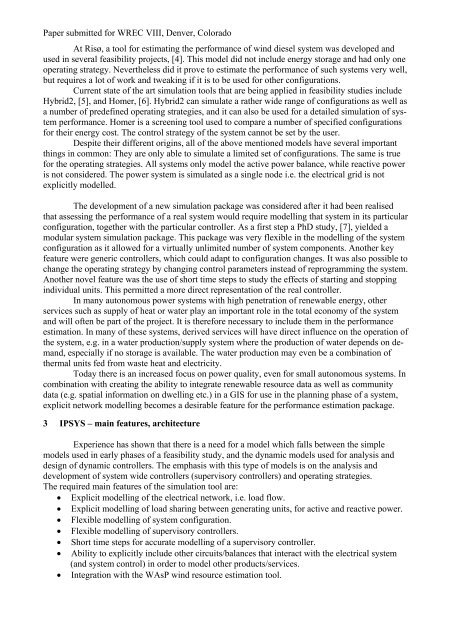IPSYS â A new simulation tool for performance assessment and ...
IPSYS â A new simulation tool for performance assessment and ...
IPSYS â A new simulation tool for performance assessment and ...
You also want an ePaper? Increase the reach of your titles
YUMPU automatically turns print PDFs into web optimized ePapers that Google loves.
Paper submitted <strong>for</strong> WREC VIII, Denver, Colorado<br />
At Risø, a <strong>tool</strong> <strong>for</strong> estimating the per<strong>for</strong>mance of wind diesel system was developed <strong>and</strong><br />
used in several feasibility projects, [4]. This model did not include energy storage <strong>and</strong> had only one<br />
operating strategy. Nevertheless did it prove to estimate the per<strong>for</strong>mance of such systems very well,<br />
but requires a lot of work <strong>and</strong> tweaking if it is to be used <strong>for</strong> other configurations.<br />
Current state of the art <strong>simulation</strong> <strong>tool</strong>s that are being applied in feasibility studies include<br />
Hybrid2, [5], <strong>and</strong> Homer, [6]. Hybrid2 can simulate a rather wide range of configurations as well as<br />
a number of predefined operating strategies, <strong>and</strong> it can also be used <strong>for</strong> a detailed <strong>simulation</strong> of system<br />
per<strong>for</strong>mance. Homer is a screening <strong>tool</strong> used to compare a number of specified configurations<br />
<strong>for</strong> their energy cost. The control strategy of the system cannot be set by the user.<br />
Despite their different origins, all of the above mentioned models have several important<br />
things in common: They are only able to simulate a limited set of configurations. The same is true<br />
<strong>for</strong> the operating strategies. All systems only model the active power balance, while reactive power<br />
is not considered. The power system is simulated as a single node i.e. the electrical grid is not<br />
explicitly modelled.<br />
The development of a <strong>new</strong> <strong>simulation</strong> package was considered after it had been realised<br />
that assessing the per<strong>for</strong>mance of a real system would require modelling that system in its particular<br />
configuration, together with the particular controller. As a first step a PhD study, [7], yielded a<br />
modular system <strong>simulation</strong> package. This package was very flexible in the modelling of the system<br />
configuration as it allowed <strong>for</strong> a virtually unlimited number of system components. Another key<br />
feature were generic controllers, which could adapt to configuration changes. It was also possible to<br />
change the operating strategy by changing control parameters instead of reprogramming the system.<br />
Another novel feature was the use of short time steps to study the effects of starting <strong>and</strong> stopping<br />
individual units. This permitted a more direct representation of the real controller.<br />
In many autonomous power systems with high penetration of re<strong>new</strong>able energy, other<br />
services such as supply of heat or water play an important role in the total economy of the system<br />
<strong>and</strong> will often be part of the project. It is there<strong>for</strong>e necessary to include them in the per<strong>for</strong>mance<br />
estimation. In many of these systems, derived services will have direct influence on the operation of<br />
the system, e.g. in a water production/supply system where the production of water depends on dem<strong>and</strong>,<br />
especially if no storage is available. The water production may even be a combination of<br />
thermal units fed from waste heat <strong>and</strong> electricity.<br />
Today there is an increased focus on power quality, even <strong>for</strong> small autonomous systems. In<br />
combination with creating the ability to integrate re<strong>new</strong>able resource data as well as community<br />
data (e.g. spatial in<strong>for</strong>mation on dwelling etc.) in a GIS <strong>for</strong> use in the planning phase of a system,<br />
explicit network modelling becomes a desirable feature <strong>for</strong> the per<strong>for</strong>mance estimation package.<br />
3 <strong>IPSYS</strong> – main features, architecture<br />
Experience has shown that there is a need <strong>for</strong> a model which falls between the simple<br />
models used in early phases of a feasibility study, <strong>and</strong> the dynamic models used <strong>for</strong> analysis <strong>and</strong><br />
design of dynamic controllers. The emphasis with this type of models is on the analysis <strong>and</strong><br />
development of system wide controllers (supervisory controllers) <strong>and</strong> operating strategies.<br />
The required main features of the <strong>simulation</strong> <strong>tool</strong> are:<br />
• Explicit modelling of the electrical network, i.e. load flow.<br />
• Explicit modelling of load sharing between generating units, <strong>for</strong> active <strong>and</strong> reactive power.<br />
• Flexible modelling of system configuration.<br />
• Flexible modelling of supervisory controllers.<br />
• Short time steps <strong>for</strong> accurate modelling of a supervisory controller.<br />
• Ability to explicitly include other circuits/balances that interact with the electrical system<br />
(<strong>and</strong> system control) in order to model other products/services.<br />
• Integration with the WAsP wind resource estimation <strong>tool</strong>.
















